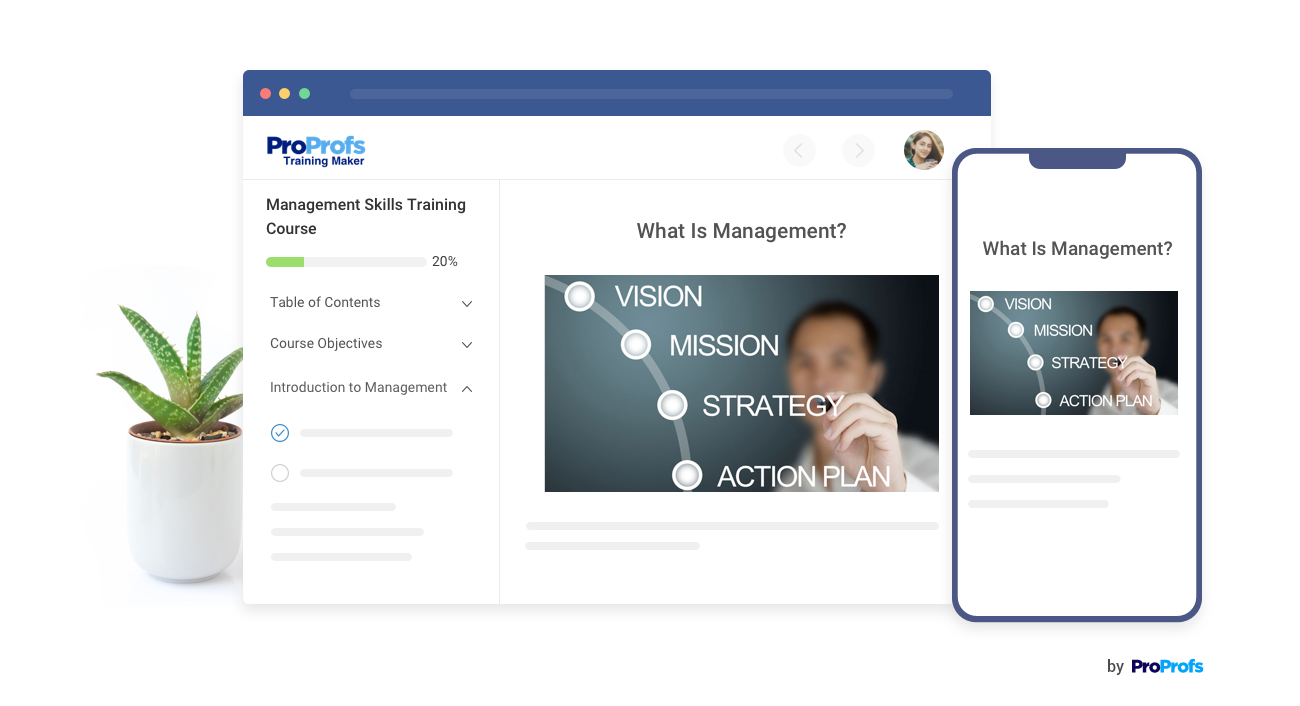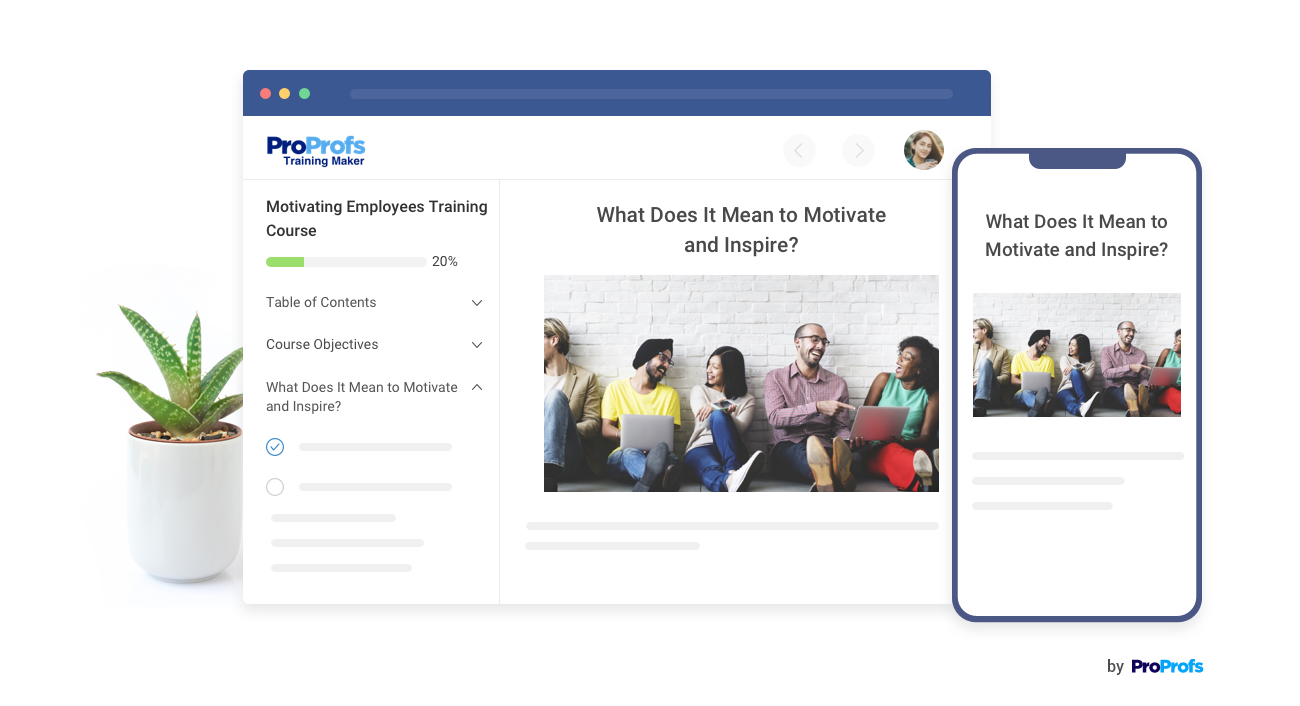I know how challenging employee retention can be, but only if you don’t know what really is to be done about it.
In my over six years in the online training space, I’ve learned about several employee engagement and management best practices.
In this blog post, I’ll present a list of proven employee retention strategies and discuss other related topics.
These approaches to employee retention can foster a sense of belonging, motivate employees, ensure loyalty, and transform your workplace.
What Is Employee Retention?
Employee retention refers to the strategies organizations use to prevent employees from leaving. It is the act of retaining productive and talented workers and reducing turnover.
Organizations do so by fostering a positive work atmosphere that promotes engagement, learning, and growth, shows appreciation to employees, provides competitive pay and benefits, and encourages a healthy work-life balance.
What are the Main Reasons for Employees’ Resignation?
Employees leave an organization for different reasons. Some common factors are:
- Lack of advancement opportunities: Employees may choose to resign if they feel limited or unfulfilled in their roles and see no prospects for growth or career advancement.
- Poor work-life balance: When employees feel overwhelmed with excessive workloads and struggle to manage personal responsibilities, they may opt to leave in search of a better work-life balance.
- Dissatisfaction with compensation & benefits: Inadequate pay, lack of benefits, or a perception of unfair compensation practices can lead employees to seek opportunities elsewhere.
- Unhealthy work environment: Toxic workplace cultures, lack of support from management, ineffective communication, or poor relationships with managers/supervisors can contribute to employee dissatisfaction and ultimately result in resignation.
- Lack of recognition and appreciation: When employees feel their contributions are disregarded or go unnoticed, they may feel undervalued and choose to leave for a work environment where their efforts are acknowledged and appreciated.
It may be noted that these are just a few examples and individual circumstances may vary.
15 Employee Retention Strategies You Can Easily Implement
These best practices are based on what I’ve seen with many organizations in their efforts to retain the best talent.
1. Implement comprehensive hiring practices
Your hiring process should be thorough and well-defined. It should include screening for culture fit and values alignment.
When new hires share the values and cultural norms of an organization, they are more likely to integrate well and collaborate effectively with their colleagues, leading to a more productive, happier, and loyal workforce.
As Harvard Business Review rightly said, “Cultural fit is the glue that holds an organization together.” It can be a key determinant of employee satisfaction and retention.
Pro tip: Use behavioral assessments to assess candidates’ past behaviors and their potential for success in your organization.
2. Create supportive work environments
Foster a positive and inclusive work culture where employees feel supported, respected, and encouraged to collaborate.
Encourage open communication, feedback, and ideas. Let employees have some level of autonomy and decision-making power in their roles while appreciating their achievements.
Pro tip: Encourage teamwork and provide opportunities for cross-functional collaboration to promote a sense of belonging.
3. Provide proper training & development
It can’t be work all the time for employees; they also need training and learning at regular intervals to grow in their roles.
Invest in continuous learning and development programs that help employees acquire new skills and grow. This will not only increase their confidence but also reflect positively on your business performance.
Pro tip: Offer a mix of internal and external training opportunities to cater to different learning styles and preferences. Start by administering the right online training courses followed by regular assessments.
4. Maintain open lines of communication
Open communication enables team members to express their thoughts, feelings, and ideas clearly and assertively. This promotes understanding and collaboration among them, leading to more effective teamwork and problem-solving.
Here’s what I often see leading organizations do in this regard. They establish regular channels for communication and feedback between their employees and managers to address concerns and provide guidance.
Pro tip: Implement an anonymous feedback system to encourage honest input from employees who may be hesitant to share openly.
5. Offer benefits and perks
Employees value benefits and perks in their jobs.
According to research, U.S. workers prioritize time away from work, including paid time off, flexibility/remote working options, and paid family leave, as the top non-insurance benefits.
A generous benefits package is essential for attracting and retaining top talent.
Therefore, it is important to provide competitive compensation, health benefits, retirement plans, and other perks to attract and retain top talent.
Pro tip: Conduct periodic market research to ensure your benefits package remains competitive and aligns with employees’ evolving needs.
6. Create career development plans
Another effective employee retention strategy I’d recommend is helping employees envision a future at your organization. You can do so by providing them with clear career paths and growth opportunities.
Providing such plans assures them that you’re invested in their professional growth and career advancement. This can lead to higher levels of job engagement, motivation, commitment, and retention.
Pro tip: Offer mentorship programs to connect employees with experienced professionals who can guide their career development.
7. Provide effective manager training
Equip managers with the skills to lead and support their teams effectively. Training for modern leaders is crucial due to the evolving nature of the workplace and the specific skills required to navigate today’s business landscape.
Adaptability, emotional intelligence, effective communication and collaboration, strategic thinking and decision-making, and continuous learning and self-improvement are some of the most sought-after skills of a manager that positively impact workplace relationships, employee happiness, and retention.
Pro tip: Invest in ongoing leadership training to ensure managers are equipped to address challenges and foster employee engagement.

8. Implement internal recognition programs
A recognition program is a strategic initiative that you can undertake to acknowledge and celebrate the achievements and contributions of employees within your company.
It includes verbal praise, written notes of appreciation, public recognition in team meetings or company-wide events, rewards and incentives, certificates, or even promotions and career advancement opportunities.
Pro tip: Give timely recognition and tailor it to align with your organization’s culture, values, and the preferences of employees.
9. Support employees’ educational endeavors
Offer support for further education, such as tuition reimbursement or flexible schedules to accommodate educational pursuits.
By providing opportunities and resources for employees to pursue further education, organizations can benefit from a more skilled and knowledgeable workforce.
Pro tip: Encourage employees to share their newfound knowledge with the team through lunch-and-learn sessions or internal workshops.
10. Encourage skill development
There should be ample opportunities for employees to enhance their skills, whether through workshops, conferences, or online courses.
I’ve personally seen how intensive learning and training programs translated into meaningful changes across my organization.
Such initiatives can help employees achieve their professional ambitions, enhance job satisfaction, and improve organizational performance. They can also help retain employees seeking to develop their skills and knowledge as they remain engaged and feel valued.
Pro tip: Create a culture that values and rewards continuous learning to motivate employees to take advantage of skill development opportunities.
11. Show employees how their work affects customers
Your employees should understand the purpose and impact of their work on your customers. Sharing customer success stories or feedback is one way.
Similarly, you may establish customer-centric metrics. For example, if an employee is responsible for quality assurance, you can measure customer satisfaction or feedback related to the quality of the product or service they receive.
Making these metrics visible to employees and discussing them regularly reinforces the importance of their work in delivering a positive customer experience.
Pro tip: Encourage cross-functional collaboration and interactions with customers to strengthen the connection between employees and the value they provide.
12. Offer fair compensation
To achieve employee satisfaction and retention, it is important to ensure they are fairly compensated for the work they are doing.
In other words, pay fairness can instill a sense of worth and foster loyalty among employees. When employees feel that their work is valued and fairly rewarded, it can lead to increased job satisfaction and motivation to perform at their best.
Pro tip: Regularly assess market salary trends to ensure your compensation packages remain competitive and aligned with industry standards.
13. Provide actionable feedback
Providing actionable feedback to employees is one of the keys to long-term retention. When employees receive regular and constructive feedback on their performance, it contributes to their growth and development.
This, in turn, improves workplace relationships, boosts employee morale, and increases the likelihood of top talent staying with your organization for the long term.
Pro tip: Use a strengths-based approach to balance feedback with recognition of employees’ existing skills and achievements.
14. Foster work-life balance
Policies and systems that support work-life balance, such as flexible work arrangements and ample vacation time, are essential for employee retention.
When employees feel that they have a good balance between their work responsibilities and personal lives, they are more likely to feel satisfied with their jobs and be committed to the organization.
By offering work-life balance initiatives, organizations can differentiate and position themselves as desirable employers.
Pro tip: Lead by example by demonstrating and promoting a healthy work-life balance within the organization.
15. Promote a positive organizational culture and values
Cultivate a culture that aligns with employees’ values and fosters a sense of pride in the organization. When employees feel connected to the organization and its values, they are more likely to feel satisfied, motivated, and committed to their work.
Remember, employees are more likely to stay with an organization that prioritizes and fosters a positive culture, leading to improved retention rates and overall success.
Pro tip: Define and communicate core values to guide employee behaviors and decision-making, in addition to creating a shared sense of purpose.
These strategies, when implemented properly, can contribute to a positive work environment, employee satisfaction, and increased retention rates within your organization. By addressing various aspects of the employee experience, you can create an environment where employees feel valued, supported, and empowered to thrive.
|
Was this helpful to you?
Employee Retention Case Study: GoogleOne well-known company that implemented a successful employee retention strategy is Google. Its employee retention strategy focuses on creating a positive work environment, providing attractive benefits, and offering career growth opportunities. Google ensures employee satisfaction by promoting a healthy work-life balance. They provide numerous perks, such as flexible working hours, onsite recreation and fitness facilities, free meals, and even on-site laundry services. Google also offers generous parental leave policies, allowing employees to spend quality time with their families. In addition to these benefits, Google invests heavily in employee growth and development. It encourages employees to pursue their passions through initiatives like “20% time“. Google also emphasizes transparent communication and employee involvement through regular town hall meetings, feedback sessions, and employee surveys. Similarly, Google understands the importance of recognizing and rewarding employees for their contributions. These strategies implemented by Google have resulted in high employee satisfaction and retention rates. It has successfully built a culture that encourages employees to stay with the company longer. |
Get Free Employee Training Software — All Features, Forever.
We've helped 567 companies train 200,000+ employees. Create courses in under a minute with our AI LMS or use 200+ ready-made courses on compliance, harassment, DEI, onboarding, and more!
How Does Training Impact Employee Retention?
Look at these statistics:
- 68% of employees prefer to learn and train at work
- 45% of workers are more likely to stay in their roles if they receive training
- Over 90% of employees say they won’t quit if they have development opportunities
From this, we can infer how training plays a vital role in staff retention.
When employees receive impactful training and development opportunities, they are more likely to feel valued and engaged in their roles. This leads to increased job satisfaction and commitment. This naturally helps retain employees.
However, effective training should not be a one-time event but an ongoing process. Continuous learning and skill development opportunities help employees stay up-to-date with changing industry trends and technology, enhancing their marketability and job satisfaction.
Overall, investing in employee training and development can significantly contribute to staff retention, as I’ve witnessed over the years, by improving job satisfaction, engagement, skills, and career opportunities.
Benefits of Employee Retention Training & Development
Here are some of the top benefits of employee retention training and development:
- Increased Employee Motivation and Commitment
- Improved Employee Performance & Productivity
- Career Development and Advancement Opportunities
- Skilled and Knowledgeable Workforce
- Time & Cost-Saving on Recruitment and Training
Let me elaborate on these points:
- Increased Employee Motivation and Commitment: Employee retention training and development programs can improve employees’ satisfaction with their jobs and employers. Employees who feel valued and supported are more likely to stay committed to the organization, which can increase motivation and reduce turnover rates.
- Improved Employee Performance & Productivity: Effective training can provide employees with the skills, knowledge, and resources they need to perform their jobs efficiently and effectively. By improving knowledge and skills gaps, employees can become better equipped to handle job complexities, boosting their productivity and overall performance.
- Career Development and Advancement Opportunities: Employees who perceive that their employers are committed to their career development are more likely to stay engaged and motivated. Training programs that provide employees with opportunities to learn new skills and advance their careers not only build a more skilled workforce but also increase the employee retention rates.
- Skilled and Knowledgeable Workforce: Employee retention initiatives provide ample opportunities to build a skilled and knowledgeable workforce. When employees have the right skills and knowledge, they can better handle complex and challenging tasks, such as handling customer complaints or managing a team of employees.
- Time & Cost-Saving on Recruitment and Training: Employee retention training programs can save organizations significant money and time. The cost of hiring new employees can be huge and it includes advertising, recruitment, and onboarding costs. By investing in training and developing existing employees, organizations can reduce the cost of hiring and training new employees, which can boost the organization’s bottom line.
By investing in the right employee training and development plans the right way, you can position yourself as an employer of choice, whereas employees can remain skillful, engaged, motivated, and loyal.
5 Best Employee Retention Courses
The training outcomes you get are, to a great extent, as good as the courses you use for the purpose. In addition to the delivery method and qualifications of instructors, quality courses shape the results of training.
With that in mind, here are five must-have courses that can help with your employee retention strategies.
1. How to Interview & Hire Like a Pro
As already hinted at above, employee retention strategies start with hiring the right people in the first place. This is because recruiting individuals who are a good fit for your organization’s culture and values increases the likelihood of them staying long-term.
This course discusses effective recruiting methods and the do’s and don’ts of hiring. It is instructed by Amber Vanderburg, a multi-award-winning international businessperson, keynote speaker, and founder of The Pathwayz Group.
The course contains worksheets, scenarios, flashcards, quizzes, and chapter feedback.
2. Motivating Employees Training Course

Motivation is like applying oil to squeaky wheels. It helps keep things moving smoothly.
Employees need the right amount of motivation at the right time to get increased engagement, job satisfaction, productivity, higher levels of commitment, and retention.
That is what this course can help you do. Learn how to motivate and supercharge your teams. Build a positive work environment for everyone and boost employee morale.
It discusses what it means to motivate and inspire employees, who can be motivated, the benefits of motivated teams, building great work relationships, and more.
3. Building Trust With Your Team
Research suggests that trust within a team plays a crucial role in employee retention. When team members trust each other, it creates a positive work environment where individuals feel safe, supported, and valued. Subsequently, this leads to higher levels of job satisfaction and commitment among employees, ultimately increasing employee retention rates.
This course explores how to build trust between team members using authenticity, logic, and empathy. It is designed to help corporate leaders learn how to use trust to ensure harmony in professional relationships.
The course contains scenarios, worksheets, tips, and assessments.
Kristen Earp is the instructor. She is a leadership coach and trainer with 20+ years of experience in the training and development industry.
4. Employee Satisfaction Survey Training Course
Satisfied employees are more likely to stay with an organization as they feel valued, motivated, and engaged in their work. These employees are less likely to seek opportunities elsewhere, resulting in higher retention rates and a more stable workforce.
Employee satisfaction assessments using surveys can help identify dissatisfaction and address concerns.
This online training course teaches participants how to conduct satisfaction surveys, analyze results, and implement changes accordingly. The course includes worksheets, scenarios, final assessments, and additional resources.
The course is led by Rafaela Estrella, founder and CEO of Estrellita Consulting, a consulting firm that equips leaders with the knowledge and confidence to navigate difficult conversations in the workplace.
5. Leading Successful Teams
Leading successful teams is positively correlated with employee retention.
When teams are led effectively, employees feel motivated, engaged, and supported, which increases their job satisfaction and commitment to the organization.
This ultimately leads to higher retention rates as employees are more likely to stay with the company when they are a part of a successful team.
By taking this course, participants will find out what it takes to lead others effectively. It will equip learners with the knowledge and skills to leverage their leadership to drive team success.
The course contains worksheets, handouts, final assessments, and chapter feedback.
The course instructor is Amber Rose, a program manager and coordinator.
Put the Strategies for Employee Retention to Work
Now that you know what employee retention looks like, its benefits, and the top strategies to retain employees longer term, it is time to see it in action.
Implement these best practices and deploy the selected retention training courses to achieve measurable results.
Along with this, you may utilize a cloud-based learning management system to manage, share, track, and analyze your employee training programs online.
When you have all these essential elements in place, a happier, engaged, and loyal workforce is just a matter of time.
 Tips
Tips
We’d love to hear your tips & suggestions on this article!
Get Free Employee Training Software — All Features, Forever.
We've helped 567 companies train 200,000+ employees. Create courses in under a minute with our AI LMS or use 200+ ready-made courses on compliance, harassment, DEI, onboarding, and more!

 We'd love your feedback!
We'd love your feedback! Thanks for your feedback!
Thanks for your feedback!







